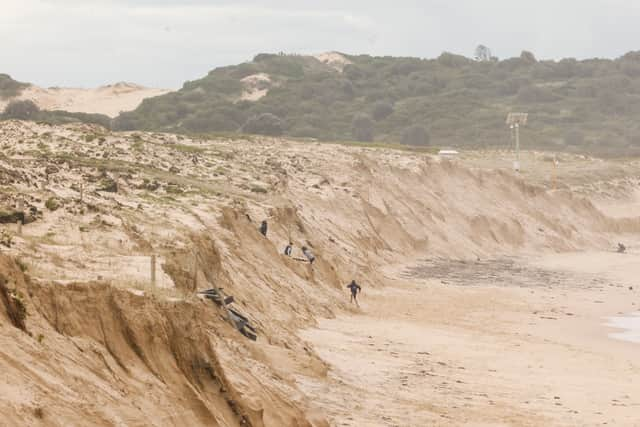Who was the Somerton Man? DNA researchers name man in Australia cold case - Carl Webb mystery explained
and live on Freeview channel 276
Researchers at the University of Adelaide believe they have finally solved the mystery of the Somerton Man.
The man was found dressed in a suit and lying against a wall on Somerton beach near Adelaide, Australia, in 1948.
Advertisement
Hide AdAdvertisement
Hide AdThe mysterious story has plagued investigators for nearly a century, with no one ever coming forward to identify the body.
Rumours that he may have been a Russian spy circulated, with the press dubbing him the “Somerton Man”.
Here is everything you need to know about who the Somerton Man really is.


What was the Somerton Man mystery?
On 1 December, 1948 the body of a man was found on Somerton Beach in Adelaide.
Advertisement
Hide AdAdvertisement
Hide AdThe man wasn’t carrying identification and had unused train tickets in his pockets.
There was no known cause of death and all of the labels of his clothes had been removed, preventing police from finding out where they were bought.
The story made headlines all around the world, with copies of his fingerprints and photograph sent to the UK and USA.
In the months that followed a pathologist found a secret pocket in the man’s jacket.
Advertisement
Hide AdAdvertisement
Hide AdInside it was a folded up piece of paper containing the words “Tamam Shud” which means “the end” or “finished” in Persian.
Further investigation discovered they are the last words of the poem “The Rubaiyat” by 11th century Iranian polymath Omar Khayyam.
The page had been torn from a book, which was eventually handed into police after an unknown man had found it in his car.
No one ever came forward to claim the man’s body, with rumours circulating that he may have been a Russian spy.
Advertisement
Hide AdAdvertisement
Hide AdWho was the Somerton Man?
The Somerton man has been identified as 43-year-old Carl “Charles” Webb.
The youngest of six siblings, Webb was born on November 16, 1905 in a suburb of Melbourne.
The engineer had a passion for poetry and was described as a “bit of a loner”.
Records show that Webb and his wife had divorced, with her returning to south Australia in 1947.
Advertisement
Hide AdAdvertisement
Hide AdOther than that, not much is known about Webb, with the mystery of why no one claimed his body still unsolved.
How did they solve the Somerton Man mystery?
Professor Derek Abbott from the University of Adelaide has claimed to have identified the Somerton Man as Carl “Charles” Webb, a 43-year-old engineer from Melbourne who enjoyed writing poetry and was described as “a bit of a loner.”
The discovery was made with help from American genealogist Colleen Fitzpatrick.
The researchers used DNA evidence from hairs caught in the plaster cast made of the man’s face to see if they could make up a DNA profile.
Advertisement
Hide AdAdvertisement
Hide AdTogether they were able to recreate a family tree made up of 4,000 relatives.
Speaking to CNN Abbot said: “By filling out this tree, we managed to find a first cousin three times removed on his mother’s side,”
Fitzpatrick added: “It’s like one of these folklore mysteries that everybody wants to solve and we did it.”
Speaking to the Guardian Abbot said: “The most important thing is that the DNA taken from the hair caught in the plaster cast of Somerton man matches with distant cousins of Carl “Charles” Webb on both maternal and paternal sides of the family.”
Advertisement
Hide AdAdvertisement
Hide AdWebb, who was divorced at the time, would not have been a stranger in south Australia as that is where his former wife lived.
Despite rumours that the Somerton man was a Russian spy, Abbott explains their findings actually match what police suspected at the time.
The Somerton man had unused train tickers in his pockets and had left his suitcase at train station.
When police searched his belongings they found items of clothing named “T. Keane”.
Advertisement
Hide AdAdvertisement
Hide AdAbbott explains Webb’s brother-in-law was called Thomas Keane, adding “It seems logical that he got his hand-me-downs from his brother-in-law.”
Despite the findings from DNA researchers, the South Australian police have said the case is “not yet complete.”
In a statement they said: “SAPOL and Forensic Science SA are undertaking DNA work on the remains of Somerton man. This work is not yet complete.
“Once that work is complete a brief will be submitted to the state coroner.”
Comment Guidelines
National World encourages reader discussion on our stories. User feedback, insights and back-and-forth exchanges add a rich layer of context to reporting. Please review our Community Guidelines before commenting.
